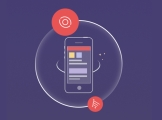|
这几天一直在努力。我试图让应用程序的客户在购物时在两种显示类型之间切换。
现在我正在使用 2 个 UICollectionView 和他们自己的自定义 UICollectionViewCell 并且两者之间的切换工作正常,但我发现使用 2 个不同的UICollectionView 正在成为一种痛苦。我为主要 UICollectionView 实现的某些东西在替代 UICollectionView 中无法正常工作。
这就是改变显示的方式。我使用带有自定义方法的 UISegmentedControl:

- (void)displayTypeSegmentSelected
{
_selectedDisplayTypeIndex = [_displayTypeControl selectedSegmentIndex];
if (_selectedDisplayTypeIndex == 0) {
NSLog(@"Single file item view selected");
_fromCollectionView = _collectionView;
_toCollectionView = _collectionView2;
} else if (_selectedDisplayTypeIndex == 1) {
NSLog(@"Grid style view selected");
_fromCollectionView = _collectionView2;
_toCollectionView = _collectionView;
}
[_fromCollectionView removeFromSuperview];
[_toCollectionView setFrame:[_superView bounds]];
[_superView addSubview:_toCollectionView];
}
我通过 stackoverflow 获得了两个不同的建议,关于更好的方法来做我想做的事情。
- 使用 2 个
UICollectionViewFlowLayout 并在它们之间切换,而不是 2 个 UICollectionView。
- 根据选择的段返回适当的自定义
UICollectionViewCell。
我觉得第一种方法会更好。我需要将界面构建器 UICollectionViewFlowLayout 设为 IBOutlet,因为连接的 UICollectionView 不是以编程方式创建的。然后我会以编程方式创建第二个 UICollectionViewFlowLayout。
在我的 displayTypeSegmentSelected 方法中,我将加载两个 UICollectionViewFlowLayout 之一,具体取决于所选的段。
单个文件显示如下所示:

网格样式显示如下所示:

问题:
我认为我有正确的想法来解决我最初的问题以及如何去做。但是,我会从更有经验的开发人员那里提出意见和示例。
你会怎么做?你能给我一个清晰的例子吗?
亲切的问候
Best Answer-推荐答案
这就是我最后做的事情。
点击特定的分段控件后,我更改了布局并重新加载了单元格。
- (void)displayTypeSegmentSelected
{
_selectedDisplayTypeIndex = [_displayTypeControl selectedSegmentIndex];
if (_selectedDisplayTypeIndex == 0) {
NSLog(@"Single file item view selected");
[_collectionView setCollectionViewLayout:_flowLayout2 animated:YES];
[_collectionView reloadItemsAtIndexPaths:[_collectionView indexPathsForVisibleItems]];
} else if (_selectedDisplayTypeIndex == 1) {
NSLog(@"Grid style view selected");
[_collectionView setCollectionViewLayout:_flowLayout animated:YES];
[_collectionView reloadItemsAtIndexPaths:[_collectionView indexPathsForVisibleItems]];
}
}
在我的 cellForItemAtIndexPath 中,根据屏幕上显示的布局,我加载了具有正确设置的特定自定义单元格。
-(UICollectionViewCell *)collectionView UICollectionView *)collectionView cellForItemAtIndexPath UICollectionView *)collectionView cellForItemAtIndexPath NSIndexPath *)indexPath object NSIndexPath *)indexPath object PFObject *)object
{
NSLog(@"collectionview 1 loaded");
static NSString *CellIdentifier = @"Cell";
VAGGarmentCell *cell = [_collectionView dequeueReusableCellWithReuseIdentifier: CellIdentifier forIndexPath:indexPath];
static NSString *CellIdentifier2 = @"Cell2";
VAGGarmentCell2 *cell2 = [_collectionView dequeueReusableCellWithReuseIdentifier:CellIdentifier2 forIndexPath:indexPath];
if ([[_collectionView collectionViewLayout] isEqual: _flowLayout]) {
[[cell activityIndicator] startAnimating];
PFFile *userImageFile = [object valueForKey PFObject *)object
{
NSLog(@"collectionview 1 loaded");
static NSString *CellIdentifier = @"Cell";
VAGGarmentCell *cell = [_collectionView dequeueReusableCellWithReuseIdentifier: CellIdentifier forIndexPath:indexPath];
static NSString *CellIdentifier2 = @"Cell2";
VAGGarmentCell2 *cell2 = [_collectionView dequeueReusableCellWithReuseIdentifier:CellIdentifier2 forIndexPath:indexPath];
if ([[_collectionView collectionViewLayout] isEqual: _flowLayout]) {
[[cell activityIndicator] startAnimating];
PFFile *userImageFile = [object valueForKey "image"];
[[cell imageView] setFile: userImageFile];
[[cell imageView] loadInBackground];
[[cell activityIndicator] stopAnimating];
[[cell title] setText:[object valueForKey "image"];
[[cell imageView] setFile: userImageFile];
[[cell imageView] loadInBackground];
[[cell activityIndicator] stopAnimating];
[[cell title] setText:[object valueForKey "title"]];
[[cell price] setText:[NSString stringWithFormat: @"£%@ GBP", [object valueForKey "title"]];
[[cell price] setText:[NSString stringWithFormat: @"£%@ GBP", [object valueForKey "price"]]];
return cell;
} else if ([[_collectionView collectionViewLayout] isEqual: _flowLayout2]) {
[[cell2 activityIndicator] startAnimating];
PFFile *userImageFile = [object valueForKey "price"]]];
return cell;
} else if ([[_collectionView collectionViewLayout] isEqual: _flowLayout2]) {
[[cell2 activityIndicator] startAnimating];
PFFile *userImageFile = [object valueForKey "image"];
[[cell2 imageView] setFile: userImageFile];
[[cell2 imageView] loadInBackground];
[[cell2 activityIndicator] stopAnimating];
[[cell2 title] setText:[object valueForKey "image"];
[[cell2 imageView] setFile: userImageFile];
[[cell2 imageView] loadInBackground];
[[cell2 activityIndicator] stopAnimating];
[[cell2 title] setText:[object valueForKey "title"]];
[[cell2 price] setText:[NSString stringWithFormat: @"£%@ GBP", [object valueForKey "title"]];
[[cell2 price] setText:[NSString stringWithFormat: @"£%@ GBP", [object valueForKey "price"]]];
return cell2;
}
return 0;
//_addToFavouritesButton = [cell addFavouriteButton];
[_addToFavouritesButton addTarget:_thisController action "price"]]];
return cell2;
}
return 0;
//_addToFavouritesButton = [cell addFavouriteButton];
[_addToFavouritesButton addTarget:_thisController action selector(addToFavouritesButtonTapped selector(addToFavouritesButtonTapped forControlEvents:UIControlEventTouchUpInside];
} forControlEvents:UIControlEventTouchUpInside];
}
在我的 viewDidLoad 中,我在这里引用了用于单个项目显示的自定义单元格的 nib 文件。
// Grab cell nib file and give a reuse identifier
[_collectionView registerNib:[UINib nibWithNibName "VAGGarmentCell2" bundle:nil] forCellWithReuseIdentifier "VAGGarmentCell2" bundle:nil] forCellWithReuseIdentifier "Cell2"]; "Cell2"];
我遇到了崩溃,但它们很难复制,尽管每次我在不同的布局之间切换时,我的内存都会不断增加。我猜我需要删除一些旧代码。我明天整理一下,用仪器检查一下。不过这已经完成了,我可以继续前进。
我可能需要重构我重复自己的代码。
关于ios - 如何在 2 个不同的 UICollectionViewFlowLayout 实例之间切换?,我们在Stack Overflow上找到一个类似的问题:
https://stackoverflow.com/questions/23246022/
|  客服电话
客服电话
 APP下载
APP下载

 官方微信
官方微信



















 UICollectionView *)collectionView cellForItemAtIndexPath
UICollectionView *)collectionView cellForItemAtIndexPath "image"];
[[cell imageView] setFile: userImageFile];
[[cell imageView] loadInBackground];
[[cell activityIndicator] stopAnimating];
[[cell title] setText:[object valueForKey
"image"];
[[cell imageView] setFile: userImageFile];
[[cell imageView] loadInBackground];
[[cell activityIndicator] stopAnimating];
[[cell title] setText:[object valueForKey forControlEvents:UIControlEventTouchUpInside];
}
forControlEvents:UIControlEventTouchUpInside];
}

